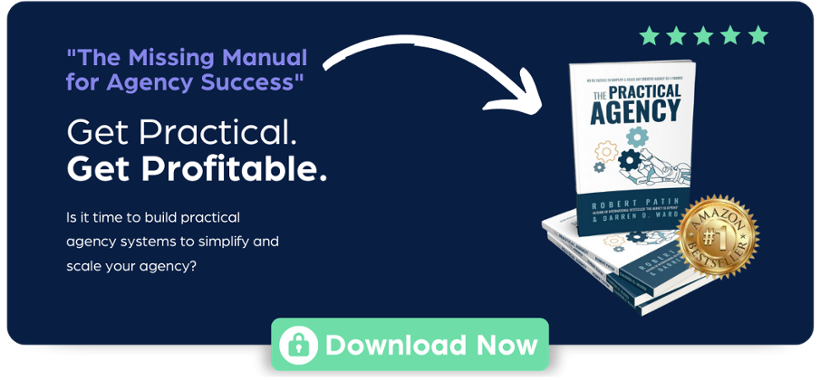Leveraging LinkedIn for Lead Generation: A Step-by-Step Guide for Agencies
Did you know that there are creative agencies making millions of dollars and signing their dream clients - JUST from using LinkedIn?
If you’re still viewing the platform as merely a digital resume primarily used by job seekers and corporate ladder climbers - it’s time to catch up. LinkedIn has transformed into a vibrant professional marketplace, teeming with potential clients actively seeking the very creativity and innovation that agencies like yours offer.
Yet, tapping into this rich network requires more than sending a few connection requests; it necessitates a strategic overhaul of how you present yourself and your agency. So whether you’ve been meaning to take LinkedIn more seriously, or if your profile still reads like a resume, allow this post to be your blueprint for transforming your LinkedIn profile from a passive bystander into a lead-generating powerhouse.
8 LinkedIn Features To Scale Your Agency's Growth
It’s never been easier to find prospective clients for your creative agency thanks to resources like LinkedIn. Its comprehensive platform is brimming with features designed to amplify your agency's visibility, credibility, and lead-generation efforts, ensuring your agency stands out in the competitive digital landscape.
Here’s a breakdown of LinkedIn's key features you can start leveraging today to start bringing more revenue into your agency:
1. Optimized Profiles:
Your LinkedIn profile is your digital first impression. Transform it from a resume to a client-attracting landing page.
You’re no longer an "Owner at XYZ Creative Agency.” Now you are "Empowering Brands with Creative Design | Transform Your Brand Identity with XYZ Agency"
2. Content Publishing and Sharing:
Share insights, case studies, and thought leadership content that resonates with your target market. This not only showcases your expertise but also amplifies your reach.
For example, you could share a case study of a recent branding project with before-and-after images, detailing the strategy behind the transformation and the impact on the client's business.
3. Advanced Search and Profile Views:
Use LinkedIn's advanced search to filter potential clients by industry, company size, and role. Get notifications to see who's viewed your profile as these are warm leads.
For example, you could create a saved search for "Marketing Managers" in the "Retail" industry with company sizes of "51-200 employees" to find potential clients who need branding services.
4. Job Boards and Talent Acquisition:
Post job openings to attract talent that aligns with your agency's creative vision and values, ensuring your team's growth aligns with your business goals.
For example, save time by asking your trusted network for a referral, or craft a job posting for a "Senior Graphic Designer" that emphasizes the desire for creativity, teamwork, and a passion for branding, including specific project examples they would work on.
5. Groups and Community Engagement:
Participate in LinkedIn groups or collaborative articles related to your industry or target market to increase visibility and gain insights into potential client challenges.
Consider joining and actively participating in groups like "Small Business Networking" or "Brand Marketing Professionals," sharing your expertise and engaging in discussions about common branding challenges.
6. LinkedIn Ads:
Use targeted advertising to showcase your agency's services directly to decision-makers in your chosen niches, crafting messages that speak directly to their pain points.
For example, you could create a sponsored content campaign targeting "Marketing Directors" in the "Consumer Goods" sector, promoting a downloadable guide on "5 Branding Mistakes Consumer Goods Companies Make."
7. Sales Navigator and Lead Generation Tools:
Utilize tools like Sales Navigator and CoPilot AI to find and connect with potential clients, sending personalized messages based on their industry challenges and needs.
For a more direct approach, send a personalized InMail to a prospect who recently commented on a branding challenge, offering specific insights or a free consultation to discuss their project in detail.
8. Analytics and Insights:
Monitor the performance of your posts, profile views, and engagement rates to refine your content strategy and optimize your LinkedIn presence for better results.
Analyze your post analytics to identify the types of content (e.g., case studies, design tips, industry insights) that generate the most engagement and leads, adjusting your content calendar accordingly.
How To Fully Optimize Your LinkedIn Profile To Maximize Engagement

A well-crafted LinkedIn profile is crucial for making that first impression count.
Here’s a step-by-step guide to ensure each section of your profile is fine-tuned to attract and engage your ideal clients:
1. Headline: Your Unique Value Proposition
- Objective: Instantly communicate your value and what you do.
- Strategy: Instead of just listing your job title, incorporate how you solve your clients' problems. For example, "Helping SMBs Achieve Branding Excellence | Creative Agency Founder | Speaker & Brand Strategist."
2. About Section: Your Story, Mission, and Vision
- Objective: Share your professional journey, the mission of your agency, and the vision for the clients you serve.
- Strategy: Use a story-telling approach to connect on a personal level. Highlight your unique approach to solving clients’ problems, and don’t forget to include a call-to-action to connect with you in some way.
3. Featured Section: Showcase Your Best Work
- Objective: Visually present your successes, case studies, or any content that positions you as an expert.
- Strategy: Regularly update this section with links to your work, media mentions, or valuable content you’ve published.
4. Experience Section: More Than Just a Job Title
- Objective: Detail your role and contributions to the agency and the success stories created under your leadership.
- Strategy: Focus on achievements and outcomes rather than just responsibilities. Use bullet points to highlight specific results or milestones achieved during your tenure.
5. Skills & Endorsements: Validate Your Expertise
- Objective: Highlight the skills that are most relevant to the services your agency offers.
- Strategy: Prioritize skills that your target clients would find most appealing, and ask colleagues and clients to endorse you for these skills.
6. Recommendations: Social Proof of Your Professionalism
- Objective: Build trust and credibility through testimonials from colleagues, clients, and industry peers.
- Strategy: Actively request recommendations, especially from clients who can speak to the results you’ve delivered. Provide them with guidance on what to focus on to make the recommendation more impactful.
7. Education and Certifications: Establish Credibility
- Objective: Demonstrate your commitment to your profession and continuous learning.
- Strategy: Include relevant degrees, certificates, and courses that add to your credibility as a leader in your field.
8. Volunteer Experience: Show Your Human Side
- Objective: Share causes you’re passionate about and any volunteer work you’ve done.
- Strategy: This is an opportunity to show a more personal side and connect with prospects who share similar values.
9. Interests: Build Connections on Shared Interests
- Objective: Highlight your interest in industry-related groups, influencers, and companies.
- Strategy: Engaging with these groups and individuals can increase your visibility and establish you as an active member of your industry community.
10. Accomplishments and Languages: Stand Out from the Crowd
- Objective: Share any awards, languages, or other notable accomplishments that can differentiate your agency.
- Strategy: This section can further establish your expertise and multifaceted skill set, making you more appealing to a diverse client base.
By meticulously crafting each section of your LinkedIn profile, you transform it into a powerful lead-generation tool that attracts the right clients to your creative agency. Remember, your LinkedIn profile is an extension of your professional brand—so make every word count.
How To Build Connections & Generate More Leads
Ever felt swarmed by an overeager salesperson the moment you step into a store, making you instantly want to escape? That same sense of being overwhelmed hits just as hard online, especially on LinkedIn, when connections can turn into relentless pitches.
The secret to success on LinkedIn lies not in the volume of your outreach, but in the authenticity and quality of your connections. Avoid the hard sell; aim instead to build genuine relationships that don't lead to your messages being ignored.
The key components of an effective LinkedIn lead generation strategy are:
1. Engage Meaningfully in Comments
Your presence in the comments section of posts by prospective leads can significantly boost your visibility and credibility. Whether it's agreeing with a point, expanding on an idea, or offering expert advice on a topic within your wheelhouse, your thoughtful engagement is invaluable. This regular interaction marks you as a familiar face, slowly building recognition and trust.
To do this you should:
- Dedicate a portion of your daily LinkedIn time to browse your feed and engage with content posted by your target audience.
- Offer genuine insights and add value with each comment, avoiding the temptation to sell your services outright.
2. Cultivate an Engaging Presence with Your Posts
The content you post on LinkedIn can serve as a magnet for potential leads, but only if it encourages interaction. Craft posts with a strong Call to Action that invite your followers to comment, whether through questions, prompts for opinions, or sharing experiences. The more engagement your posts receive, the wider their reach extends, increasing your visibility across the platform.
To do this you should:
- When creating content, think about what questions or challenges your target audience faces and how you can address them in a way that encourages dialogue.
- Use LinkedIn's analytics to understand which types of posts generate the most engagement and tailor your strategy accordingly.
3. Participate in Collaborative Efforts for Credibility
Collaborating on articles, participating in panel discussions, or contributing to industry publications on LinkedIn can significantly enhance your standing as a thought leader. These collaborations provide social proof of your expertise and broaden your network, attracting potential leads through shared credibility.
To do this you should:
- Seek out opportunities for collaboration with peers in your industry. This can be through joint webinars, co-authored articles, or LinkedIn Live sessions.
- Offer to contribute to industry-related publications or blogs as a guest expert, ensuring your contributions are linked back to your LinkedIn profile.
Remember, the goal isn't to make a sale on the first interaction but to lay the groundwork for a relationship that could eventually lead to business opportunities.
4 Tips to Attract, Find, and Engage More Prospects on LinkedIn
For many creative agency owners, the thought of jumping into online conversations can feel daunting, especially if you're more reserved or new to the social media game. But fear not—LinkedIn is teeming with opportunities for meaningful engagement, even for the social media shy.
Here's how you can start inserting yourself into conversations in a way that feels natural and builds your presence on the platform:
1. Industry Trends and Insights
Your feed is likely filled with posts discussing the latest trends in your industry. Whether it's a new design tool, marketing strategy, or business model, these topics are ripe for engagement.
For example: A fellow agency owner shares an article about the rise of virtual reality in advertising. You can chime in with your thoughts on how this could affect design choices or client demands, or even share a brief experience you've had with this technology in your work.
You could:
- Ask a question about the article to encourage further discussion.
- Share a brief insight or prediction on how this trend could evolve.
2. Success Stories and Challenges
Many of your connections will share their success stories or discuss challenges they've faced. These posts are an excellent opportunity to offer congratulations, words of encouragement, or advice based on your own experiences.
For example: A connection posts about a successful campaign they've just completed. Congratulate them and ask a question about their approach or the biggest challenge they overcame. This not only shows your interest but also encourages them to share valuable insights.
You could:
- Offer genuine congratulations and ask a follow-up question to deepen the conversation.
- Share a similar challenge you've faced and how you addressed it, fostering a sense of camaraderie.
3. Questions and Requests for Advice
It's not uncommon for professionals to turn to their LinkedIn network for advice or solutions to problems. These posts are a direct invitation for you to share your expertise.
For example: A connection in your target market posts a question about the best tools for project management in creative teams. Given your experience, you can recommend tools you've found effective, briefly explaining why.
You could:
- Provide a clear, concise recommendation based on your experience.
- Offer to discuss further in a private message if they need more detailed advice, subtly opening the door for deeper engagement.
4. Polls and Surveys
Polls and surveys are increasingly popular on LinkedIn and can offer a low-pressure way for you to participate in the conversation.
For example: A connection posts a poll asking which marketing strategy will dominate the next year: content marketing, social media, or PPC. Vote in the poll and leave a comment with your reasoning, potentially sparking a broader discussion.
You could:
- Vote and provide your perspective in the comments, inviting further interaction.
- Share how your agency is approaching these strategies, adding depth to your response.
For agency owners looking to increase their LinkedIn engagement, these examples serve as a starting point. Remember, the goal is to become a familiar face in your network's feed, contributing value and expertise in a way that resonates with your connections.
Harnessing LinkedIn's Power: A Gateway to Sales Success
Embracing LinkedIn's full spectrum for lead generation is a game-changer for creative agency owners. It's not just a platform for connections but a strategic tool for showcasing your agency's unique value, building credibility, and establishing a sustainable sales pipeline.
By optimizing your profile, engaging meaningfully with your network, and consistently contributing valuable insights, you transform LinkedIn into a dynamic lead generation engine. Start leveraging LinkedIn today, and unlock a new horizon of opportunities for your agency's growth and success.










